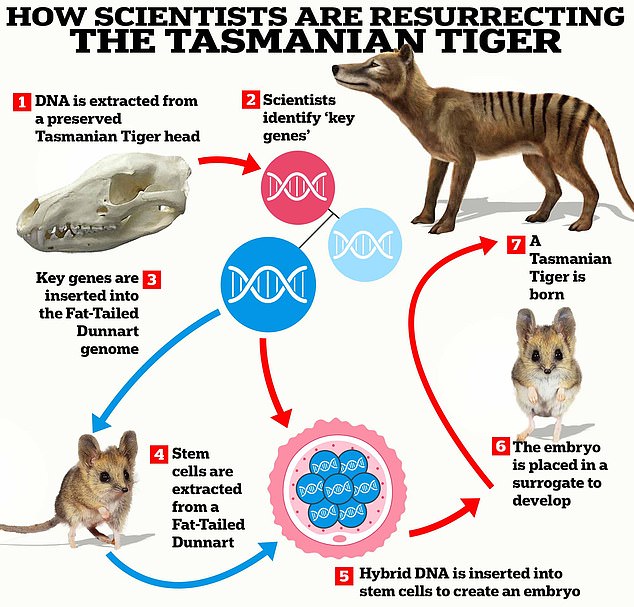It is one of the most distinctive extinct animals in the world and can be found on the Tasmanian coat of arms, government logo and even state license plates.
Now, it may not be long before real Tasmanian tigers, also known as thylacines, are seen again.
Colossal Biosciences, a US-based startup, has taken an important step towards resurrecting lost species.
The team has successfully reconstructed the animal’s genome with 99.99 percent accuracy.
Ben Lamm, chief executive of Colossal Biosciences, told MailOnline: “We have not publicly set a date for thylacine, but as our announcement today shows, the team is making significant progress in many key areas of research.”
Scientists at Colossal Biosciences say they have made a breakthrough in bringing the Tasmanian tiger back from extinction. This graphic shows how this process will work.
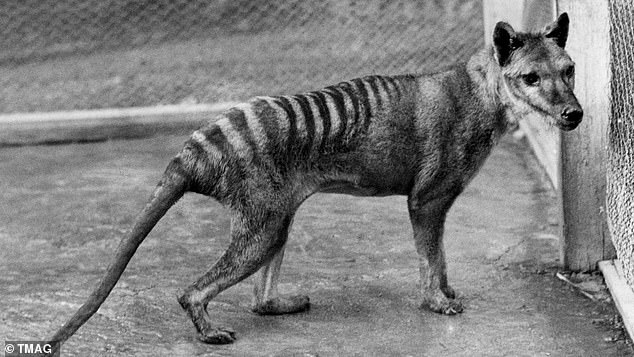
The last living Tasmanian tiger, or thylacine, died in captivity at Beumaris Zoo (pictured) in 1936.
To bring the Tasmanian tiger back from extinction, scientists first need to reconstruct the species’ lost genome.
In an important step towards this goal, Colossal Biosciences today announced the creation of the most complete Tasmanian tiger genome ever created.
Using samples taken from an exceptionally well-preserved specimen, researchers were able to assemble the 3 billion bases within the Tasmanian tiger genome with 99.9 percent accuracy.
The genome now only has 45 gaps, which Colossal says will close in the coming months.
Because DNA is exceptionally fragile, it typically breaks down quickly after the death of the organism.
However, since the last Tasmanian tiger died less than 100 years ago, there are several extremely well-preserved specimens in museums around the world.
This allowed researchers at Colossal Biosciences to extract long sections of DNA from the head tissues of a 110-year-old Tasmanian tiger that had been skinned and placed in ethanol.
Dr. Beth Shapiro, Chief Scientific Officer at Colossal, says: “The thylacine samples used for our new reference genome are among the best-preserved ancient specimens my team has worked with.
“It is rare to have a sample that allows us to go beyond ancient DNA methods to such an extent.”
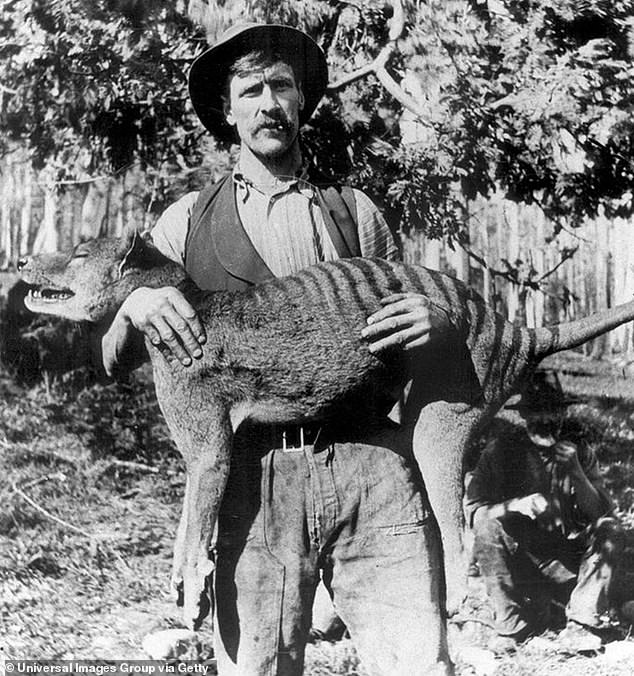
More than 100 years after the last Tasmanian tiger died, researchers have recreated the species’ genome with 99.9 percent accuracy.
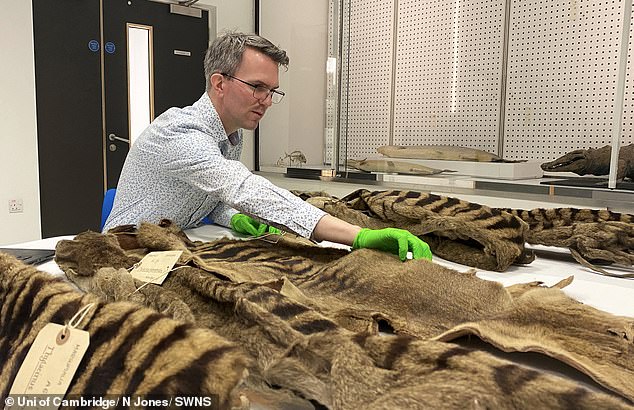
Because Tasmanian tigers became extinct so recently, there are many well-preserved specimens, such as skins (pictured).
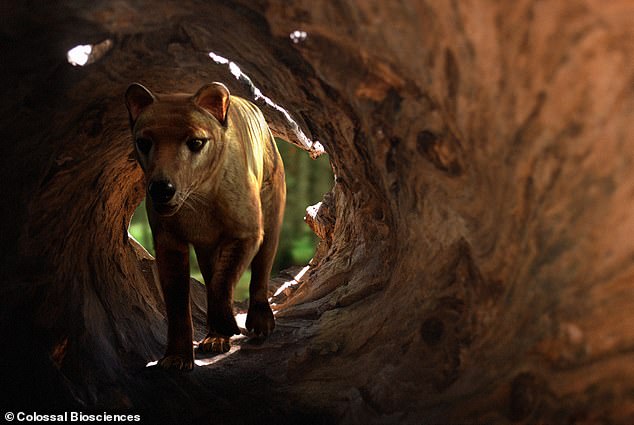
This is the first time an ancient genome has been reconstructed with such precision and could soon pave the way for the genetic engineering of the first living Tasmanian tigers.
Dr Andre Pask, member of Colossal’s Scientific Advisory Board and director of the Thylacine Integrated Genomic Restoration Research Laboratory at the University of Melbourne, said: “This exceptional sample provides us with a fantastic opportunity to understand gene expression in thylacines. .
‘With this new resource in our hands we will be able to determine what a thylacine tasted like, what it could smell, what type of vision it had and even how its brain worked.’
Now that the Tasmanian tiger’s genome has been reconstructed, the extinction process will begin by comparing it to its closest living relative, the fat-tailed dunnart.
Because their genomes are so similar, scientists hope to identify the “key genes” that determine whether an organism is more like a Tasmanian tiger or more like a Dunnart.
Using gene editing techniques like CRISPR, scientists can cut and paste these key genes into the fat-tailed dunnart’s genome to create hybrid DNA.
The fat-tailed dunnart’s cells are then chemically converted into pluripotent stem cells, a type of cell that can transform into any type of tissue.
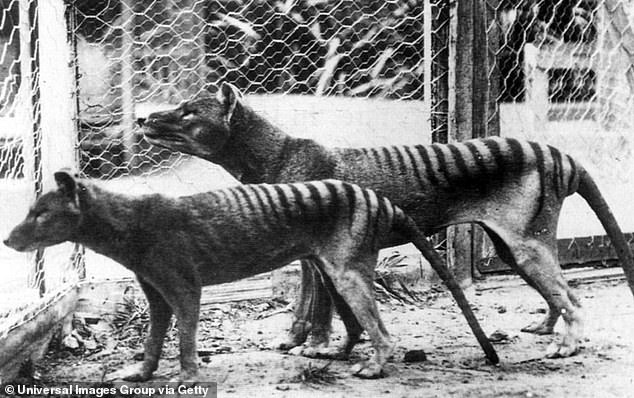
Scientists say this is the most complete genome ever created for an extinct animal. The genome only has 45 gaps that will be patched in the coming months
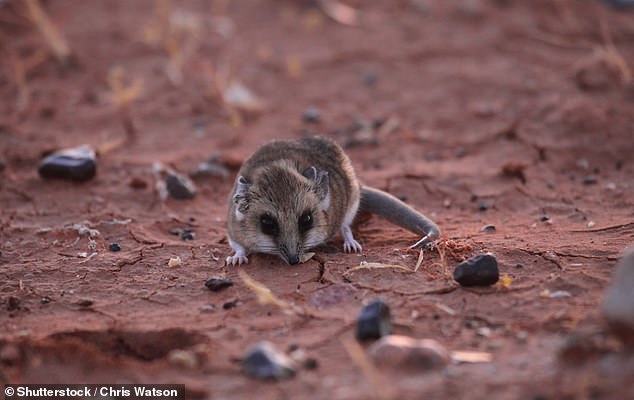
By comparing these genes to the Tasmanian tiger’s closest relative, the fat-tailed dunnart (pictured), scientists hope to identify the “key genes” that make the Tasmanian tiger different from other animals.
By inserting hybrid DNA into these cells, scientists can grow eggs, sperm or even embryos with the genetic potential to become Tasmanian tigers.
Embryos or fertilized eggs can then be inserted into a fat-tailed dunnart surrogate mother who will carry the hybrid to term.
Once the embryo has developed and hatched, the resulting animal should be identical to the once-extinct Tasmanian tiger.
Colossal Biosciences says it has already begun using the reconstructed genome to begin isolating some critical key genes.
For example, Colossal Biosciences has focused on the distinctive shape of the Tasmanian tiger’s skull and jaw.
By comparing the reconstructed genome with the genomes of wolves and dogs, the scientists identified two sets of genes that they call thylacine wolf accelerated regions (TWARs).
When three sections of the mouse genome were swapped through TWAR, the researchers found they could change the shape of the mice’s heads to make them look more like a Tasmanian tiger.
Sara Ord, director of species restoration at Colossal Biosciences, says: “This is crucial proof of the power of Colossal’s approach and an important step towards thylacine de-extinction.”
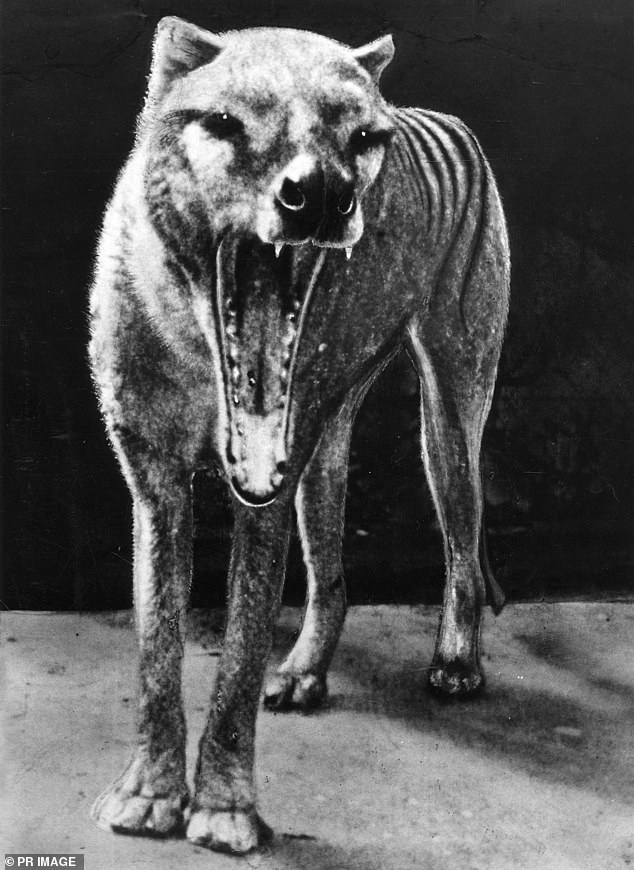
Colossal Biosciences has focused on recreating the distinctive skull and jaw of the Tasmanian tiger by identifying several ‘key genes’ responsible for this distinctive feature.
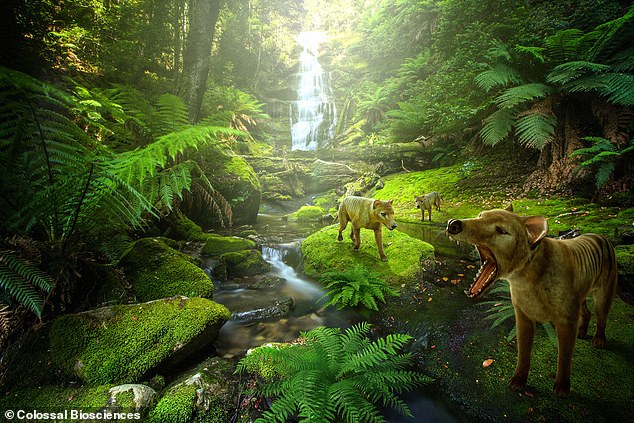
Colossal Biosciences says its plan is to reintroduce the Tasmanian tiger to Tasmania so it can re-establish self-sustaining breeding populations.
Colossal Biosciences has not yet said when the first Tasmanian tigers will be born, but the company hints they could arrive soon.
Speaking to MailOnline earlier this month, Lamm said the Tasmanian Tiger project could end before the first mammoths are born in 2028.
Although not yet confirmed, that could mean that Tasmanian tigers will come back from extinction within the next four years.
The company is so confident in achieving this goal that it is already planning what to do with its newborn Tasmanian Tigers.
Lamm says: “Colossal’s goal is to fully recover the thylacine into the ecosystem with a population diverse enough for the species to not only survive but thrive again in the wild.”
“Colossal, in collaboration with conservation groups, environmentalists, representatives of indigenous peoples, universities and local representatives, among others, is working to identify possible reconstruction sites.”
Mr Lamm adds that several ecological studies are already being carried out and that potential sites should be announced “in the next year or two”.


